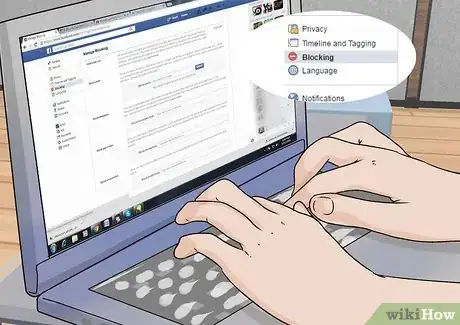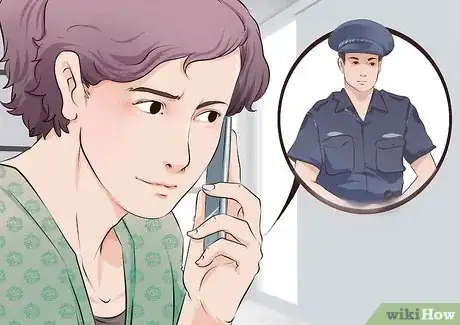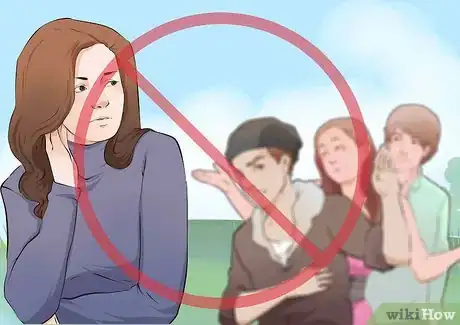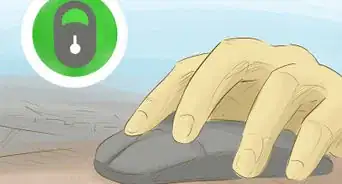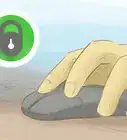This article was co-authored by Tasha Rube, LMSW. Tasha Rube is a Licensed Social Worker based in Kansas City, Kansas. Tasha is affiliated with the Dwight D. Eisenhower VA Medical Center in Leavenworth, Kansas. She received her Masters of Social Work (MSW) from the University of Missouri in 2014.
There are 11 references cited in this article, which can be found at the bottom of the page.
This article has been viewed 85,116 times.
Sometimes guys hit on people who aren't interested, and a clear "no" puts them back on the right track. Other times, they keep on going. You might be feeling increasingly uncomfortable or even unsafe. Here is how to shake a guy who refuses to listen to you telling him no.
Steps
Handling Men Online and Over the Phone
-
1Explain that you are not interested. With everyone everywhere on a smart phone, tablet, or laptop, technology is fast becoming one of the primary ways humans communicate. Social media networks, online forums, and dating websites and chat-rooms are common stomping grounds for creeps who won't take no for an answer. Perhaps you were previously friendly with another user and he said or did something that made you uncomfortable. You have a right to tell him to back off.
- In the clearest way possible, tell him that you are no longer interested in chatting or maintaining contact. Request that the person stop contacting you. Your request might be as straightforward as "Can you please stop contacting me?"
-
2Block contact.[1] If you have clearly and firmly asked the person to stop contacting you, and he continues anyway, the next step is to block this person from your social media profiles or chat-rooms. Removing this guy as a friend or follower should prevent him from being able to contact you any further.
- Sit down and go through each network in which you have had contact with him and block him from being able to view your profile and reach out to you.
- There are two easy ways to block contact on Facebook. You can visit the person's profile and select Block from the "..." menu. You can also click the padlock symbol on your on profile. The prompt "How do I stop someone from bothering me?" should appear. Select this, and then enter the name or email address of the user you want to block.[2]
Advertisement -
3Contact the website administrators. If you need help blocking an unfriendly user, you can always ask for assistance from the administrators of whatever site you're using. Typically, these customer service agents will make haste of blocking this person and the person will not be able to contact you again.
-
4Change your email address. If you gave out your email address, or if it was listed on your user accounts, it might be a good idea to change it. If the person has not been contacting you via email, you may be okay to keep using your current one.
-
5Get evidence of cyberstalking behavior. If a person online is stalking you, it's important to gather any inappropriate messages, emails, photos, or other means of contact to show to someone in authority. If you are not sure if your case counts as cyberstalking, consider the following. Cyberstalking occurs when someone:[3] [4]
- Monitors your computer or internet use or social media posts
- Posts inappropriate pictures or spreads rumors about you online
- Threatens to hurt you or someone you care about
- Messages, texts, or contacts you when you do not want him to
- Sends you viruses or content that are potentially damaging to your computer or phone
-
6Involve the police. If blocking this person or getting help from a chat-room or social media website administrator doesn't solve the problem, you need to get legal assistance. Contact the cops and bring them up to date on the situation, being sure to provide them with evidence to help your case.
Handling Men in Person
-
1Assess whether he is a threat.[5] [6] Not listening to what you say is a red flag—but how much of a red flag it is depends on the circumstances. At best, he is seriously misguided, and at worst, he is potentially violent and very unsafe. You always have a right to say no; this is important in considering whether and how to protect your safety.
- Learn how to read emotions. A tense or harsh tone of voice may indicate someone is angry or upset. Facial cues might indicate the same, such as drawn in eyebrows, dilated nostrils, and a hard, piercing stare. If you notice these signs, try to end the interaction as soon as possible, or get in sight of others.[7]
-
2Listen to your instincts. If you feel that this guy is likely to hurt you or make you extremely uncomfortable, you're probably right. If you think that he isn't horrible but just misguided, then you're probably right. Err on the side of playing it safe. You don't want to get hurt.
- Learn to trust your gut. How do you feel in your body when you are around this person? Does your heart beat fast in alarm? Do your fists clench? Do you find yourself holding your breath? All of these could be bodily signs that this person is making you uncomfortable, even if he has a smile on his face.[8]
-
3Be cautious if you are getting bad vibes or feel afraid of him. Direct confrontation may lead to escalation, so avoid telling him off; he might start threatening you or turn violent. Trust your instincts and find ways to either end the interaction or get around others.
- For example, you might look at your watch and suddenly exclaim that you are late for a meeting or appointment. This can be a good way to get away from the person. It also demonstrates that someone somewhere is waiting on your arrival, and will be wary if you are late.
-
4Go to safer ground if a guy is getting pushy. Some men become loud, threatening, or violent if a woman keeps saying no. He is less likely to do this if you are somewhere with more witnesses, and you are more likely to run into a kind bystander who can help you out.
- Crowded areas are far safer than isolated places.
- Look for other women. Many women can recognize the signs that a woman is being harassed by a guy, and can swoop in to the rescue or get outside help.
-
5Look for an authority figure. If he won't listen to you, maybe he'll listen to someone in a position of power, whether it's a boss, bartender, or teacher. This person may also be able to threaten consequences if he doesn't knock it off.
- At work and school, you have a right to focus on your work in a nonthreatening environment free of harassment.
-
6Try avoiding him. See if you can politely excuse yourself when he comes by. Say something like "I need to finish a project," "It's getting late," or "I'll see you around." Most people understand that if they follow you out, they would look like a creepy jerk, so he is likely to not do that.
- If he starts following you, go straight for a crowd, authority figure, or police.
-
7Enlist the support of friends, coworkers, or even random bystanders. If he won't listen to you being straightforward, then it's time to get outside help. Explain the situation and ask for help in extricating yourself from this situation.
- If he's pressing you in public, start crying or saying no, loudly. If he tries to cover it up by acting like he wants to comfort you, push him away. People will recognize he's bothering you, and they'll come help.
- If he lays his hands on you after refusing to leave, then scream. Scream loudly and persistently until he leaves or someone comes running.
-
8Get help from law enforcement if needed. An extremely persistent or violent guy may leave you with no other option than a restraining order or harassment charges. You deserve to be able to go about your day without worrying about what he'll do next, and you certainly deserve to be at peace.
Protecting Yourself in the Future
If you want to reduce the chances of being vulnerable, there are certain safety measures you can take. Following these tips can reduce the risk, but they can't guarantee your safety, nor is it your fault if you aren't perfectly alert all the time. The actions of a dangerous man are his fault, never yours.
-
1Learn basic self-defense practices.[9] Self-defense is much more than just fighting back. It encompasses skills relating to becoming more aware of your surroundings, considering your options when in danger, practicing assertiveness, and attempting to de-escalate a potentially threatening situation. In reality, fighting back may actually make this guy more angry and result in you getting hurt. Sign up for a local self-defense class in which you can learn how to deflect violence and protect yourself in such situations.
- In a tight situation, your ultimate goal is to get to safety. If you have no choice but to use physical violence, aim for the body parts in which you can inflict the most damage - and, therefore, have time to run away. Try to jab, punch, or kick the attacker in the eyes, nose, throat, crotch or knees.[10]
-
2Maintain control. Using alcohol or drugs in situations with people who you are not totally comfortable can leave you in a compromising position. Your defenses are down at these times, and you are less likely to be able to read your environment and anticipate threats. If you are just hanging out or beginning to date a new person, keep alcohol and drugs off the table.
- A guy who does not want to take no for an answer wants to be in control. If alcohol and drugs are in the picture, you may mistakenly be giving this person more control to potentially drug you or coerce you into sex or other activities.[11]
-
3Be aware of what's out there about you on the internet. Many social media profiles display phone numbers and emails, which may be an opening for a creep to contact you. In the future, change your privacy settings so that your personal information is displayed only to those you trust (or no one at all). Also, be mindful of what you are posting online. Someone who means you harm has an easier time of locating you if you regularly tag yourself at different locations.
-
4Avoid going to secluded places with people you don't know.[12] If you are meeting a new guy for a blind date, choose to go somewhere public - and meet him at the location; don't give him your home address. Make sure someone else knows where you are at all times. If you can, try to set up a group or double date so that other friends are with you.
-
5Remember that any acts of violence are his fault, not yours. It is his responsibility to act like a decent human being, not yours to be perfectly wary and watchful at every moment. If things go terribly wrong and someone does hurt you, it is not your fault. You have the right to say no, and it is his fault if he does not respect that.
Warnings
- Do not touch him unless he puts his hands on you or others. If he does, then you can protect whoever he touches, including yourself.⧼thumbs_response⧽
References
- ↑ https://www.womenshealth.gov/violence-against-women/types-of-violence/stalking.html#b
- ↑ https://www.facebook.com/help/168009843260943
- ↑ https://www.womenshealth.gov/violence-against-women/types-of-violence/stalking.html#b
- ↑ http://www.emerson.edu/about-emerson/offices-departments/diversity/violence-prevention-response/learn-more/stalking-threats
- ↑ http://lifehacker.com/5960444/detect-if-a-person-is-a-threat-at-a-glance
- ↑ https://www.psychologytoday.com/articles/201210/whats-in-face
- ↑ https://www.scienceofpeople.com/microexpressions/
- ↑ https://www.psychologytoday.com/blog/prescriptions-life/201202/avoid-pain-maximize-success-listen-and-follow-your-instincts
- ↑ http://www.ncdsv.org/images/selfdefenseinfo_lacaaw.pdf
- ↑ http://lifehacker.com/5825528/basic-self-defense-moves-anyone-can-do-and-everyone-should-know?sidebar_promotions_icons=testingoff&utm_expid=66866090-67.e9PWeE2DSnKObFD7vNEoqg.1&utm_referrer=https%3A%2F%2Fwww.google.com
- ↑ http://www.pamf.org/teen/risk/drugs/daterape/
- ↑ http://www.umhb.edu/titleix/how-minimize-risk-date-rape

